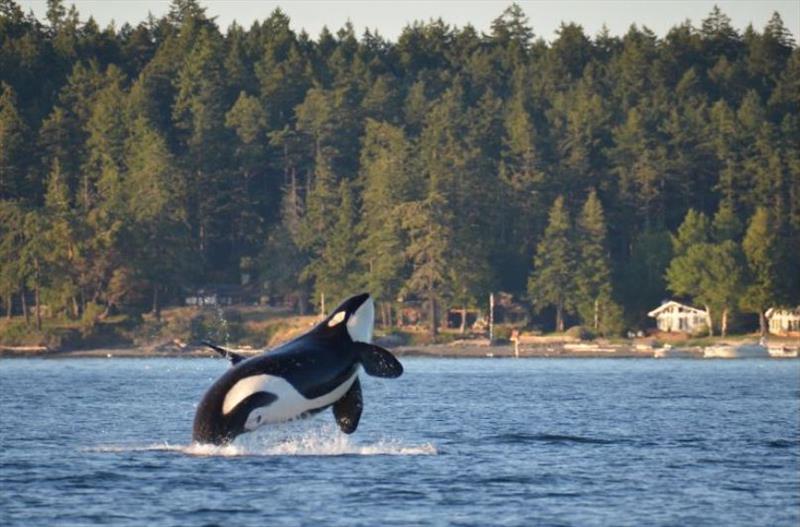
Vulnerable killer whales need extra space
by NOAA Fisheries 11 Oct 2018 12:09 PDT

A Southern Resident killer whale breaches in Puget Sound © Monika Wieland Shields
To further protect endangered Southern Resident killer whales, NOAA Fisheries' West Coast Region is joining the Pacific Whale Watch Association (PWWA) and The Whale Museum's Soundwatch Boater Education Program in asking boaters to give extra space to vulnerable whales recently identified by scientists.
New photogrammetry observations by NOAA Fisheries' Southwest Fisheries Science Center and SR3: SeaLife Response, Rehabilitation and Research have documented the declining condition of K25, a 27-year old adult male in K pod, as well as a number of pregnancies within all three pods in the Southern Resident population. Respecting space around the whales will help them forage undisturbed and protect their prospects for recovery.
"The aerial photos are an early indicator of changes in body condition and help us to identify at-risk whales," said Lynne Barre, NOAA Fisheries Recovery Coordinator for Southern Resident killer whales. "While the decline in K25's body condition is not as severe as we saw with J50 this summer, it is a warning signal."
Although veterinarians never determined what caused J50 to become so severely emaciated, K25's declining weight could be the result of the loss of his mother last year. Female Southern Residents share prey with their male offspring which helps them meet the increased energy demands of their larger bodies. K25 no longer has that help, and is nearing the average life span of 30 years for male killer whales.
"The aerial photos also indicate that at least one whale in each pod is pregnant. This is vital news for this critically endangered population," says Scott Rumsey, NOAA Fisheries West Coast Region Deputy Regional Administrator. "We ask that vessels minimize disturbance of these pregnant whales, in addition to K25, to maximize the chances of successful pregnancies."
Based on the current observations NOAA Fisheries has not consulted experts regarding intervention with K25 at this time, as the agency did with J50. Researchers will minimize disturbance of the whales while opportunistically collecting fecal samples and observations that could help track K25's condition, as well as that of the pregnant whales.
PWWA plans to reduce vessel traffic around these whales, and NOAA Fisheries and Soundwatch ask other boaters to do the same. This summer PWWA adopted new standards for viewing Southern Resident killer whales, including limiting boat numbers and reducing speeds to minimize noise that can disrupt the whales' foraging. These go beyond BeWhaleWise guidelines that apply in both the United States and Canada.
"This is one action we all can take to be sure that these whales can forage peacefully at a critical time for them," said Jeff Friedman, PWWA president. "We ask that everyone please put the health of the whales first."
Federal regulations limit the viewing distance for killer whales to no less than 200 yards, and 400 yards in the path of the whales. PWWA members also reduce speeds to no more than seven knots within one kilometer of whales, and limit their viewing time with groups of whales. NOAA Fisheries asks that all boaters adhere to the PWWA's more protective guidelines.
"We appreciate the whale watching community taking action and setting an example on the water, and we ask everyone to do the right thing for the whales right now," Barre said.
The Washington Department of Fish and Wildlife and San Juan County have also asked boaters to respect an important foraging area for killer whales on the west side of San Juan Island by staying a quarter mile offshore, and a half-mile from Lime Kiln Lighthouse. San Juan County's Marine Resources Committee has also adopted a new whale warning flag to raise awareness with boaters when whales are present and is working with Soundwatch to step up boater education efforts.
For more information: